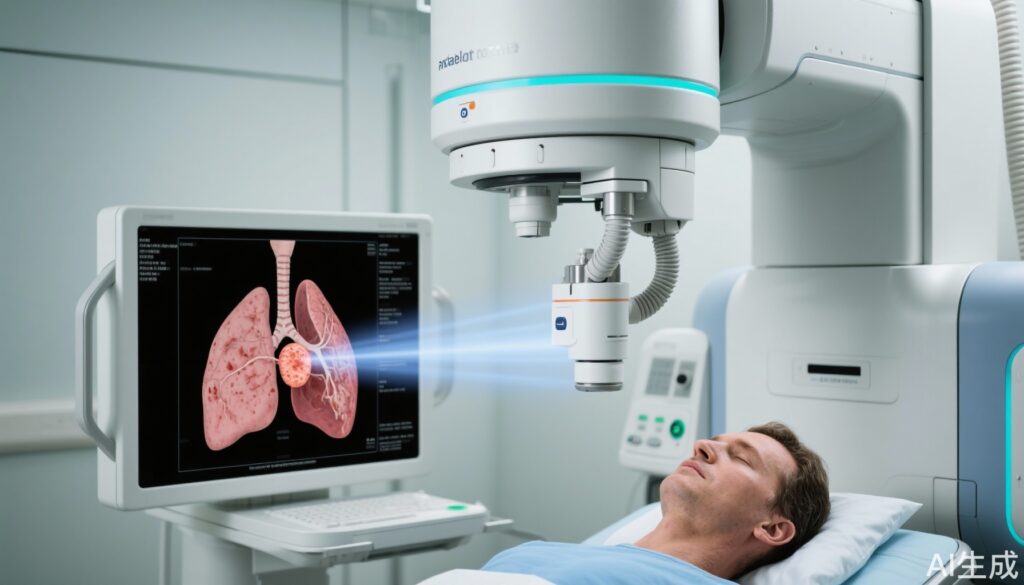Introduction
Limited-stage small-cell lung cancer (SCLC) is conventionally treated with concurrent chemoradiotherapy, which combines platinum-etoposide chemotherapy with thoracic radiotherapy (TRT). Despite aggressive multimodal treatment, relapse rates remain high and long-term survival is limited. Established TRT regimens commonly utilize a dose of 45 Gy delivered twice daily in 30 fractions over three weeks. However, there has been ongoing investigation whether increasing the TRT dose can lead to improved local tumor control and survival without adding substantial toxicities. This randomized, open-label phase II trial compared the efficacy and safety of a higher dose of TRT—60 Gy given twice daily in 40 fractions—to the standard 45 Gy twice-daily schedule in patients with limited-stage SCLC. The current report presents the final survival outcomes, detailed long-term toxicity profiles, and relapse patterns derived from this trial.
Study Background and Disease Burden
SCLC comprises approximately 15% of all lung cancers but is characterized by rapid tumor growth and early metastasis. Limited-stage disease, confined to one hemithorax and regional lymph nodes, offers a window for curative intent treatment. The current standard of care includes concurrent twice-daily thoracic radiotherapy and chemotherapy. Despite best available treatment, 5-year survival remains poor, commonly below 30%. Local recurrence after chemoradiotherapy contributes substantially to treatment failure, raising interest in optimizing radiotherapy dosing to improve local tumor control and survival outcomes. However, concerns about escalating doses relate to potential increased acute and late toxicities including esophagitis, pneumonitis, and chronic swallowing dysfunction.
Study Design and Methods
This multicenter randomized, open-label, phase II trial enrolled 170 patients diagnosed with limited-stage SCLC from multiple centers. Eligible patients were adults 18 years or older, with Eastern Cooperative Oncology Group (ECOG) performance status 0-2, staged by 18F-fluorodeoxyglucose positron emission tomography-computed tomography (FDG PET-CT) and brain magnetic resonance imaging (MRI). Patients were randomized 1:1 to receive either higher-dose twice-daily thoracic radiotherapy (60 Gy in 40 fractions) or the standard twice-daily schedule (45 Gy in 30 fractions), administered concurrently with chemotherapy.
All patients received four cycles of platinum-etoposide chemotherapy. Responders were offered prophylactic cranial irradiation (PCI) to reduce the risk of brain metastasis. Radiotherapy planning predominantly utilized three-dimensional conformal radiotherapy (3D-CRT) techniques, with a median planning target volume of 305 cm3.
Key Findings
Among 170 randomized patients (89 allocated to 60 Gy and 81 to 45 Gy), the median patient age was 65 years, with nearly one-third aged 70 years or older. Most patients were female (57%) and had a good performance status (0-1 in 89%). The majority (83%) presented with stage III SCLC. Treatment adherence was high across both arms.
Survival Outcomes: Median overall survival was significantly longer in the 60 Gy group at 43.5 months, compared to 22.5 months in the 45 Gy group. The hazard ratio for death with high-dose TRT was 0.68 (95% CI, 0.48–0.98), indicating a 32% relative reduction in mortality risk (p=0.037).
Toxicity Profile: Importantly, increasing the dose to 60 Gy twice daily did not significantly increase acute severe toxicities. Incidences of grade 3-4 esophagitis were comparable between the high-dose and standard arms (21% vs. 18%, p=0.83). Grade 3-4 pneumonitis was rare in both groups (3% vs. 0%, p=0.39). Long-term toxicities included esophageal strictures observed in two patients in the 60 Gy arm, and severe long-term eating and swallowing dysfunction in 11 patients (5 in 60 Gy, 6 in 45 Gy).
Relapse Patterns: While detailed relapse data were not elaborated in this summary, the trial reported no unexpected relapse pattern differences between dose groups, suggesting the survival benefit is not offset by increased distant failures.
Expert Commentary
This trial provides valuable evidence supporting higher-dose twice-daily thoracic radiotherapy in limited-stage SCLC. The substantial improvement in median survival by nearly 2 years is clinically meaningful and suggests that dose intensification optimizes local tumor control without adding substantial acute or late toxicity. The comparable rates of esophagitis and pneumonitis indicate careful planning and delivery of higher doses are achievable in contemporary radiotherapy practice.
Limitations include the phase II design and open-label nature, which may introduce bias in patient management or reporting. Also, the sample size is relatively modest and longer follow-up would be helpful to fully characterize late toxicity. Nonetheless, the trial’s pragmatic inclusion criteria and use of modern imaging and radiotherapy techniques enhance generalizability.
Consensus guidelines increasingly recognize the role of TRT dose and fractionation in limited-stage SCLC, but an optimal regimen balancing efficacy and toxicity remains debatable. This study supports considering higher-dose, twice-daily TRT in eligible patients, potentially changing current standard practice pending confirmation from larger phase III trials.
Conclusion
In patients with limited-stage small-cell lung cancer, twice-daily thoracic radiotherapy at 60 Gy in 40 fractions improves overall survival significantly compared with the standard 45 Gy in 30 fractions, without increasing severe acute or long-term toxicity. These findings encourage dose intensification of thoracic radiotherapy as a practicable strategy to improve curative outcomes in this aggressive disease. Further phase III studies and long-term observation are warranted to consolidate these promising results and inform clinical guidelines.
References
Grønberg BH, Killingberg KT, Fløtten Ø, Bjaanæs MM, Brustugun OT, Madebo T, Langer SW, Risumlund SL, Schytte T, Helbekkmo N, Neumann K, Yksnøy Ø, Engleson J, Fluge S, Naustdal T, Giske LE, Nyman J, Tsakonas G, Halvorsen TO. High-Dose Versus Standard-Dose Twice-Daily Thoracic Radiotherapy in Limited-Stage SCLC: Final Survival Data, Long-Term Toxicity, and Relapse Patterns in a Randomized, Open-Label, Phase II Trial. J Thorac Oncol. 2025 Aug;20(8):1108-1119. doi: 10.1016/j.jtho.2025.04.007. Epub 2025 Apr 19. PMID: 40258573.



